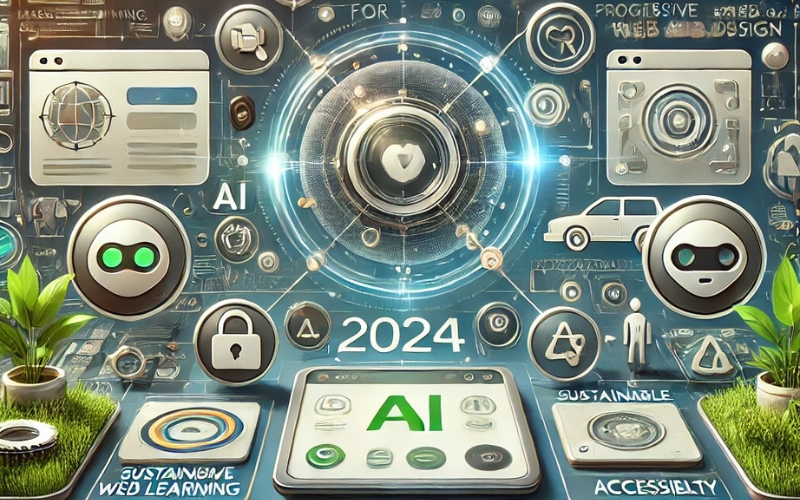The world of web development is constantly evolving, with new trends and technologies reshaping the way we design, build, and interact with websites. As we step into 2024, several key advancements are setting the stage for a more innovative, efficient, and inclusive digital experience. From the transformative power of AI and machine learning to the growing dominance of Progressive Web Apps (PWAs) and the emphasis on sustainable, accessible design, these trends are not only redefining the technical landscape but also catering to the diverse needs of users worldwide. Understanding and leveraging these trends will be critical for developers and businesses aiming to stay ahead in the digital arena.
The Rise of AI and Machine Learning in Web Development

Artificial Intelligence (AI) and Machine Learning (ML) are revolutionizing the landscape of web development, bringing capabilities that enhance user experience, streamline processes, and optimize website performance. As we move through 2024, their adoption continues to grow, providing businesses with advanced tools to meet dynamic user expectations.
Transforming Website Functionality
AI and ML have introduced a new level of sophistication to websites, transforming their functionality beyond static content and basic interactions. Chatbots, for instance, have become an essential feature for customer service and support. These intelligent virtual assistants provide real-time, personalized responses to users, ensuring seamless navigation and addressing inquiries 24/7. Popular examples include tools like Intercom and ChatGPT-powered plugins, which adapt to customer needs and even escalate complex issues to human agents.
Personalized user experiences are another key area where AI shines. Through data analysis and ML algorithms, websites can tailor content, product recommendations, and interface layouts to individual preferences. E-commerce giants like Amazon have set a benchmark in this space by leveraging AI-driven insights to boost conversions and customer satisfaction.
Predictive analytics further enhances user engagement by anticipating user actions and providing proactive solutions. For example, ML models can predict user needs based on browsing history, recommending content or services likely to resonate with them. This approach not only improves user retention but also builds brand loyalty.
Tools and Frameworks for Integration
Developers now have access to a wide range of tools and frameworks that simplify AI and ML integration into websites. Frameworks like TensorFlow.js and PyTorch enable the creation of robust ML models that can be deployed on web platforms. Additionally, AI APIs, such as Google Cloud AI and IBM Watson, offer pre-trained models that handle complex tasks like natural language processing and image recognition with minimal coding effort.
No-code platforms like Dialogflow also empower developers to create intelligent conversational interfaces without requiring deep expertise in AI, reducing the entry barrier for smaller businesses.
Real-World Examples of AI-Driven Solutions
Numerous companies are already leveraging AI to deliver standout web solutions. For example, Netflix utilizes AI algorithms to analyze viewing patterns and recommend content, making its platform highly engaging. Similarly, fashion retailer ASOS employs AI to suggest outfits and styles, enhancing the shopping experience and driving sales.
AI and ML are no longer optional for forward-thinking businesses—they are essential components of modern web development. By adopting these technologies, developers can ensure their websites remain competitive, adaptive, and user-focused in 2024 and beyond.
Progressive Web Apps (PWAs): Bridging the Gap Between Web and Mobile

Progressive Web Apps (PWAs) are revolutionizing the web development landscape, seamlessly combining the best features of web and mobile applications. In 2024, their adoption continues to rise as businesses and developers seek efficient, cost-effective solutions to enhance user experiences across platforms.
What Are PWAs?
PWAs are web applications designed to function like native mobile apps. They are accessed through a browser but can be installed on a user’s device, providing app-like functionality without requiring downloads from app stores. Built with modern web technologies like HTML, CSS, and JavaScript, PWAs leverage APIs to deliver a responsive, fast, and engaging experience.
The appeal of PWAs lies in their ability to adapt to various devices and network conditions. They enable features like offline access, push notifications, and smooth animations, making them an attractive option for businesses aiming to deliver a high-quality user experience while minimizing development costs.
Benefits of PWAs
1. Offline Functionality
One of the most significant advantages of PWAs is their offline capability. Using service workers—a script that the browser runs in the background—PWAs cache resources, allowing users to access content even without an internet connection. This feature is especially valuable for industries like e-commerce and news media, where continuous access to content is crucial.
2. Faster Loading Times
PWAs are designed for speed. By preloading essential assets and using advanced caching strategies, they deliver near-instant loading, reducing bounce rates and improving user satisfaction. A faster-loading PWA can significantly impact a website’s performance metrics, such as search rankings and conversion rates.
3. Mobile-First Design
PWAs prioritize mobile-first design, ensuring they are fully responsive and work seamlessly across devices of all screen sizes. This approach aligns with the increasing preference for mobile browsing, catering to users who demand convenience and efficiency.
4. Cost-Effectiveness
Developing and maintaining a single PWA is often more cost-effective than creating separate native apps for Android and iOS. Businesses save resources while reaching a broader audience through the web.
Industries and Tools Adopting PWAs
Industries such as e-commerce, travel, and media are at the forefront of PWA adoption. Brands like Alibaba, Pinterest, and Starbucks have successfully implemented PWAs, reporting improved user engagement and conversion rates.
Developers can create PWAs using tools and frameworks like Google’s Lighthouse, Vue.js, and Workbox. These resources simplify the process of building and optimizing PWAs, ensuring they meet industry standards.
As businesses aim to deliver seamless, fast, and reliable digital experiences, PWAs will continue to dominate web development trends, bridging the gap between web and mobile in 2024 and beyond.
Focus on Sustainable and Accessible Web Design

In 2024, web development is no longer just about aesthetics and functionality—it’s about creating experiences that are sustainable and accessible to all users. As environmental concerns and inclusivity take center stage, web development professionals and businesses are prioritizing designs that align with these values, ensuring their websites leave a positive impact both socially and environmentally.
Eco-Friendly and Energy-Efficient Web Design
Sustainability in web development focuses on reducing the environmental impact of websites by minimizing energy consumption and optimizing resources. Websites with heavy graphics, excessive scripts, and large media files contribute to higher carbon emissions by consuming more server resources and energy. To address this, web development practices include:
- Optimizing Code: Streamlining HTML, CSS, and JavaScript reduces server load, leading to faster load times and lower energy use.
- Efficient Media Usage: Compressing images, using vector graphics, and incorporating modern formats like WebP ensure minimal data usage without compromising quality.
- Green Hosting Solutions: Hosting websites on platforms powered by renewable energy, such as GreenGeeks and Kualo, is gaining popularity for its sustainability.
By implementing these strategies, web development efforts not only lower their carbon footprint but also offer faster, more efficient performance, benefiting both users and the environment.
Accessibility: Prioritizing Inclusivity in Design
Accessibility is a crucial component of modern web development, ensuring websites can be used by everyone, regardless of disabilities or impairments. Developers follow established guidelines like the Web Content Accessibility Guidelines (WCAG) and Accessible Rich Internet Applications (ARIA) standards to make digital content usable for all.
Key accessibility features in web development include:
- Keyboard Navigation: Ensuring websites are fully navigable using a keyboard is essential for users with mobility impairments.
- Screen Reader Compatibility: Proper semantic HTML and ARIA labels help screen readers interpret web content accurately for visually impaired users.
- Color Contrast: Maintaining sufficient contrast between text and background ensures readability for users with color blindness or low vision.
- Alt Text for Images: Providing descriptive alt text makes images understandable for screen readers, enhancing the user experience.
Accessible web development not only adheres to legal standards in many countries but also expands the reach of businesses by including a wider audience.
Tools for Sustainable and Accessible Web Development
Developers have access to tools that make creating sustainable and accessible websites easier. Tools like Lighthouse assess performance, accessibility, and eco-friendliness, while WAVE and axe DevTools help identify and address accessibility issues. Additionally, platforms like Squoosh optimize images for lower energy consumption, aiding sustainable web development.
By embracing sustainable and accessible web development, developers can create websites that are not only user-friendly but also environmentally responsible and inclusive, shaping a better digital future in 2024 and beyond.
Conclusion
Web development in 2024 is characterized by a focus on innovation, efficiency, and inclusivity. Trends like AI and machine learning are enhancing website functionality and personalization, while Progressive Web Apps are bridging the gap between web and mobile experiences. Simultaneously, the shift towards sustainable and accessible web design reflects a commitment to environmental responsibility and user inclusivity. Embracing these trends will not only ensure cutting-edge digital experiences but also foster long-term growth and relevance in an ever-competitive online environment. For developers and businesses alike, staying informed and adapting to these changes is the key to success in the evolving digital landscape.

